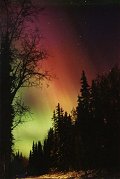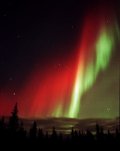|
Summary: This long-lasting geomagnetic
storm (a G2-class disturbance) began on
Monday, Nov. 6, when a coronal mass ejection that left the Sun three
days earlier hit
Earth's magnetosphere. Sky watchers across the northern tier of US states
and Canada reported red-colored aurora during the hours before
local dawn on Monday. The storm continued as the interplanetary
magnetic field
(IMF) around Earth turned southward and remained so for more
than 24 hours. (A southward-pointing IMF weakens the magnetosphere's
defenses against solar wind gusts.) Observers in Europe and Canada
and at higher-latitudes in the United States again reported intermittent
aurora after nightfall on Monday Nov. 6th until local dawn on
Tuesday, Nov. 7th.
Unless otherwise stated, all images are copyrighted by the photographers.
|
|
Photographer, Location |
Images |
Comments |
 |
Jan Curtis,
Fairbanks, AK |
#1,
#2, more |
The right-hand panel of photo #2
shows the Pleiades, Jupiter and Saturn shining through a colorful
veil of aurora. Photo settings: Kodak PJ800, 35 mm lens, f/2.0
@ 10 secs, expect 15 secs for red aurora. |
 |
Mark
Vornhusen, near Laufen, Germany |
#1,
#2, more |
Many of Vornhusen's striking images, captured
in Germany near its border with Austria, show moonlit clouds
and recognizable asterisms (like the Big Dipper) in the background. |
 |
Sandra Barnett,
Sublimity, Oregon, 15 miles southeast of Salem |
#1 |
Sandra Barnett: "This is a picture of aurora
with Orion in the background, it was my third attempt at photographing
the Northern Lights. I used 800 speed Kodak Max film, the exposure
was 10 seconds. F-stop 2.8, 50mm lens." |
 |
Yusuke Ebihara,
Jokkmokk, Sweden |
#1,
#2 |
Photos captured between 1900 and 2000 UT on November
6, 2000. Photo settings: Kodak Royal Gold 400, Nikon New FM-2
with 24mm f2.0, exposure time of approx. 15-20 sec. |
back
to spaceweather.com |



